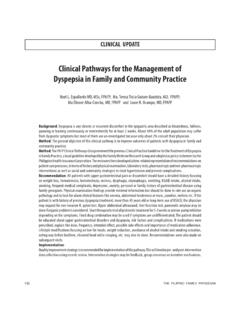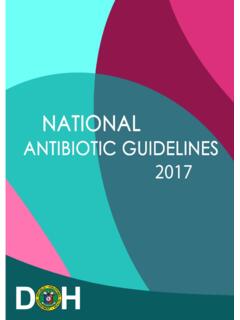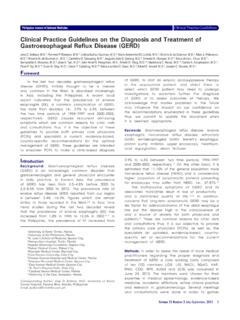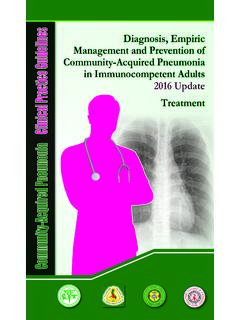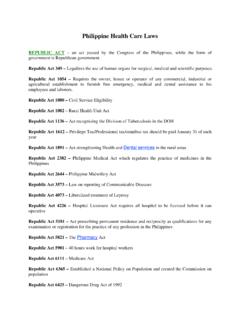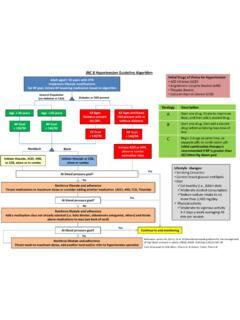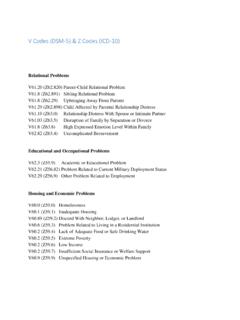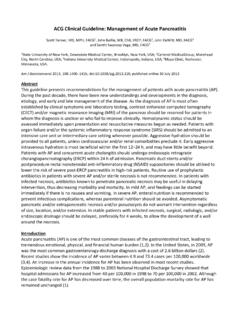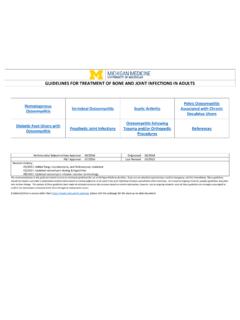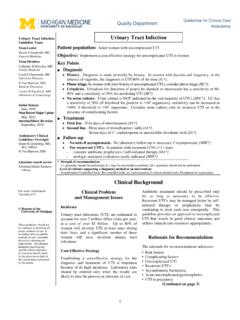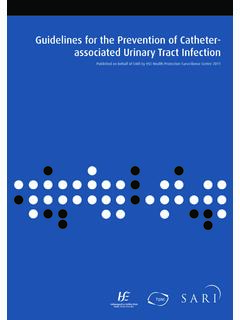Transcription of Philippine Clinical Practice Guidelines on the Diagnosis ...
1 Philippine Clinical Practice Guidelines on UTI 2015 Update: Part 2 1 Philippine Clinical Practice Guidelines on the Diagnosis and management of urinary tract infections in Adults 2015 Update: Part 2 Asymptomatic Bacteriuria in Adults, Recurrent urinary tract Infection, and Complicated urinary tract Infection Task Force Members Organizations Philippine Society for Microbiology and Infectious Diseases Philippine Obstetrics and Gynaecology Society Philippine Society of Nephrology Philippine Urological Association Philippine Academy of Family Physicians Chair: Mediadora C. Saniel, MD Co-chair: Marissa M. Alejandria, MD Complicated urinary tract Infection Cluster Arthur Dessi E. Roman, MD (Head) Allan Raymond S. Tenorio, MD (Head) Rufino T. Agudera, MD Anne Margaret J. Ang, MD Regina P. Berba, MD Jill R. Itable, MD Marie Carmela M. Lapitan, MD Maria Nicollete M.
2 Mariano, MD Katha W. Ngo-Sanchez, MD Recurrent UTI Cluster Marissa M. Alejandria, MD Coralie Therese Dimacali, MD Leilanie Apostol-Nicodemus, MD Rommel Bataclan, MD Tenille Tan, MD Mark Brian Tan, MD Asymptomatic Bacteriuria in Adults Cluster Ricardo M. Manalastas Jr., MD (Head) Louella P. Aquino, MD Shahreza L. Baquiran, MD Sybil Lizzane R. Bravo, MD Jennifer T. Co, MD Maria Meden P. Cortero, MD Lorina Q. Esteban, MD Analyn F. Fallarme, MD May Gabaldon, MD Jill R. Itable, MD Alfredo M. Lopez, Jr, MD Helen V. Madamba, MD Josefa Dawn V. Martin, MD Erwin R. De Mesa, MD Sharon Faith B. Pagunsan, MD Oliver S. Sanchez, MD Katha W. Ngo-Sanchez, MD Research Associates: Richelle G. Duque, MD and Grace Kathleen T. Serrano, MD Philippine Clinical Practice Guidelines on UTI 2015 Update: Part 2 2 TABLE OF CONTENTS 3 Introduction 3 Methodology 6 Asymptomatic Bacteriuria in Adults 17 Recurrent urinary tract Infection in Women 46 Complicated urinary tract infections : General Considerations 70 Specific Issues of Concern in Complicated UTI 70 UTI in Diabetic Patients 74 Catheter-Associated urinary tract Infection 99 Renal Abscess 108 UTI in Renal Transplant Patients 115 Perioperative Antibiotic Prophylaxis for Patients Who will Undergo Urologic Procedures 124 urinary Candidiasis Introduction Philippine Clinical Practice Guidelines on UTI 2015 Update.
3 Part 2 3 INTRODUCTION urinary tract infections (UTI) are among the leading indications for seeking healthcare and using antimicrobials in the community and hospital settings. The Philippine Clinical Practice Guidelines on the Diagnosis and management of urinary tract infections in Adults were first published in 1998 and revised in 2004 to provide primary care physicians and specialists with evidence-based recommendations on the care of patients with UTI. The current Guidelines further update the recommendations following an extensive review of more recent literature. For the first time the GRADE (Grading of Recommendations Assessment, Development, and Evaluation) system was used to develop Guidelines in infectious diseases in the country. The outputs are consensus recommendations of a panel of clinicians convened by the Philippine Society for Microbiology and Infectious Diseases (PSMID) in collaboration with the Philippine Obstetric and Gynecological Society (POGS), Philippine Society of Nephrology (PSN), Philippine Academy of Family Physicians (PAFP), and Philippine Urological Association (PUA).
4 The focus of the Guidelines is on Diagnosis , treatment, and prevention of UTI in adults and consists of two parts: Part One Acute Uncomplicated UTI and UTI in Pregnancy Part Two Asymptomatic Bacteriuria, Recurrent UTI and Complicated UTI In formulating optimal approaches to the care of both outpatients and inpatients with UTI, the panel considered several issues related to changing prevalence and resistance patterns of uropathogens, availability and practicability of diagnostic tests, and cost-effectiveness and ecological adverse effects (collateral damage) of treatment. The Guidelines are not intended to supersede a healthcare provider s sound Clinical judgment. Variations in Clinical presentation, presence of comorbidities, or availability of resources may require adaptation of the recommendations to specific settings.
5 METHODOLOGY The PSMID, in collaboration with POGS, PSN, PAFP, and PUA, convened a task force of clinicians representing different expertise including infectious diseases, nephrology, family medicine, obstetrics and gynecology, urology, and internal medicine. The members of this task force were divided into four clusters, each headed by a senior specialist, and served as the technical working group for formulating the Guidelines . The areas covered were: Cluster A uncomplicated UTI (acute cystitis and pyelonephritis), Cluster B UTI in pregnancy and asymptomatic bacteriuria, Cluster C complicated UTI, and Cluster D recurrent UTI. Each cluster conducted a review and analysis of the relevant English literature published since 2004 and, for some topics, even earlier studies. The quality of the evidence was evaluated using the GRADE system as indicated in Table 1.
6 The cluster then drafted guideline recommendations and graded them as STRONG or WEAK depending on the quality of the evidence, balance of potential benefits and harm, and translation into Practice in specific settings and patient groups. Thus, high-quality evidence did not necessarily constitute strong recommendations; conversely, strong recommendations could arise from low-quality evidence if the benefits outweigh the undesirable consequences. Introduction Philippine Clinical Practice Guidelines on UTI 2015 Update: Part 2 4 Table 1. GRADE system Category Definition Strength of Recommendation Strong Desirable effects (benefits) clearly outweigh the undesirable effects (risks) Conditional Desirable effects probably outweigh the undesirable effects but the recommendation is applicable only to a specific group, population, or setting; or the benefits may not warrant the cost or resource requirements in all settings Weak Desirable and undesirable effects closely balanced;or uncertain, new evidence may change the balance of risk to benefit No recommendation Further research is required before any recommendation can be made Quality of Evidence High Consistent evidence from well-performed RCTs or strong evidence from unbiased observational studies.
7 Further research is very unlikely to change confidence in the estimate of the effect Moderate Evidence from RCTs with important limitations or moderately strong evidence from unbiased observational studies; further research is likely to have an important impact on confidence in the estimate of the effect Low Evidence for one critical outcome from observational studies, from RCTs with serious flaws or from indirect evidence; further research is very likely to have an important impact in the estimate of effect and is likely to change the estimate Very Low Evidence for one critical outcome from unsystematic Clinical observations or very indirect evidence; any evidence of effect is very uncertain In addition to quality of evidence, the following domains were considered in grading the strength of the recommendations: 1.
8 Balance of benefits versus harms and burdens 2. Values and preferences: Is the recommendation likely to be widely accepted or Is there significant variability or uncertainty in values and preferences that the recommendation is unlikely to be accepted? 3. Resource implications: financial costs/implications, infrastructure, equipment, human resources/expertise, cost-effectiveness 4. Feasibility: Is the recommendation achievable in the setting where the greatest impact is expected? A series of face-to-face meetings of the task force with representatives from all four clusters was held to discuss each cluster s draft outputs. The task force members Introduction Philippine Clinical Practice Guidelines on UTI 2015 Update: Part 2 5 developed a consensus in grading the quality of the evidence and strength of the recommendations using the GRADE technique.
9 Throughout the development process, expert advice on methodological issues was provided by a task force member proficient in the GRADE system. GRADE tables summarizing the quality of the evidence retrieved were generated for each guideline question. Segments of the Guidelines were presented in various fora including annual conventions of specialty societies such as POGS, PSN, and PSMID to elicit feedback. The Guidelines were finalized after a few more meetings and e-mail correspondence among the task force members and cluster heads. At regular intervals, the task force leaders will determine the need for revisions to the Guidelines . Implementation strategies will also be periodically reviewed. References: 1. Guyatt GH, Oxman AD, Vist GE, Kunz R, Falck-Ytter Y, Alonso-Coello P, et al. GRADE: an emerging consensus on rating quality of evidence and strength of recommendations.
10 BMJ 2008; 336:924 6. 2. Guyatt GH, Oxman AD, Kunz R, Falck-Ytter Y, Vist GE, Liberati A, et al. Going from evidence to recommendations. BMJ 2008; 336:1049 51. Asymptomatic bacteriuria Philippine Clinical Practice Guidelines on UTI 2015 Update: Part 2 6 ASYMPTOMATIC BACTERIURIA IN ADULTS Summary of recommendations 1. When is asymptomatic bacteriuria diagnosed? All Diagnosis of asymptomatic bacteriuria (ASB) should be based on results of urine culture specimens that are collected aseptically and with no evidence of contamination. For asymptomatic women, bacteriuria is defined as two consecutive voided urine specimens with isolation of the same bacterial strain in quantitative counts 100,000 cfu/mL. Strong recommendation, High quality of evidence In men, a single, clean-catch voided urine specimen with one bacterial species isolated in a quantitative count 100,000 cfu/mL identifies bacteriuria.
